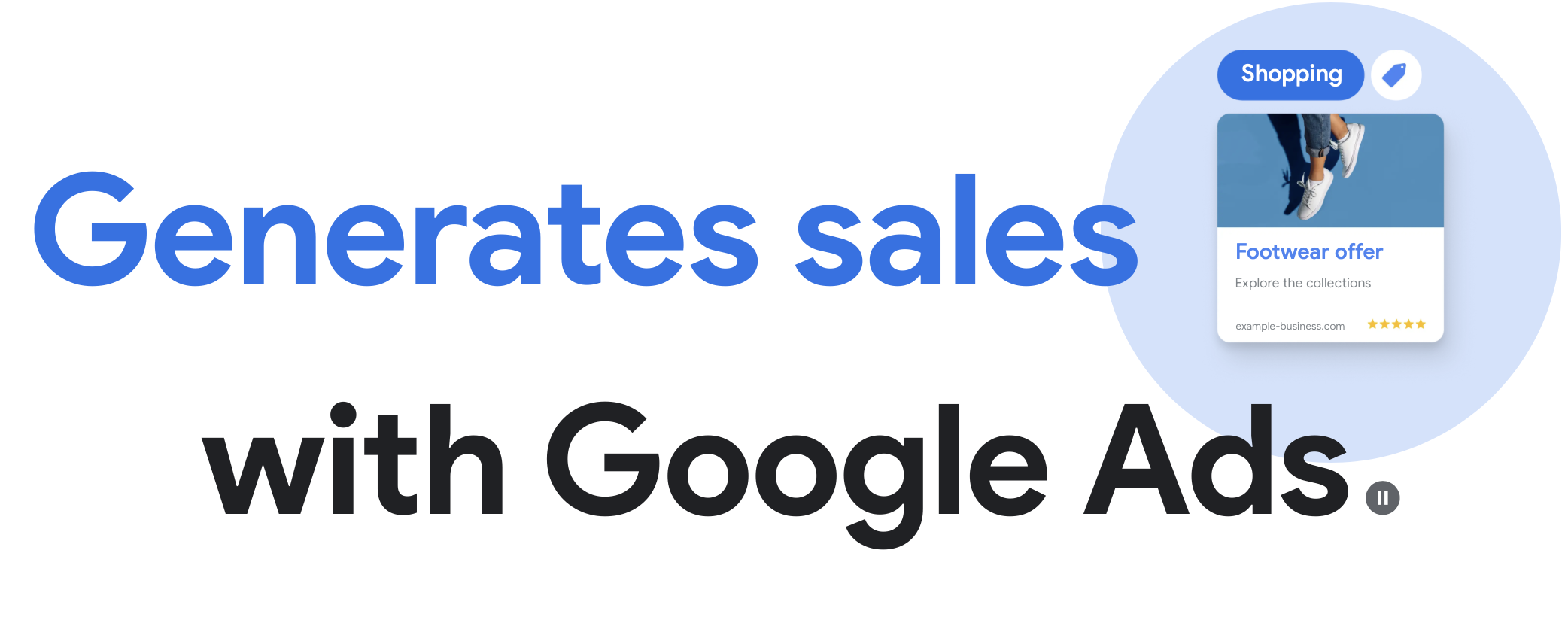The Potentiality of Google Ads
Is no secret that Google Ads has revolutionized online advertising. With billions of daily searches and millions of websites in its network, Google Ads provides businesses with unrivaled reach and visibility. But what exactly are Google Ads? And why does it has an immense potentiality for your business? Let's dive deeper into this topic.

What are Google Ads?
Google Ads, formerly known as Google AdWords, is an online advertising platform developed by Google. It enables businesses to display their ads on Google's search engine results pages (SERPs), as well as on websites and apps that are part of Google's ad network.
Ads on Google can take various forms, including text ads, display ads, video ads, and shopping ads. These ads are displayed to users who are searching for specific keywords or browsing websites and apps that are relevant to the advertiser's target audience.
For example, if a user searches for "best running shoes" on Google, they may see ads from various shoe brands that have targeted this specific keyword. Similarly, if a user is browsing a website about fitness, they may see ads related to fitness equipment or apparel.
Why Google Ads are Essential for Businesses
There are several reasons why Google Ads are essential for businesses looking to maximize their online presence and achieve their goals:
- Increased Visibility: With Google Ads, businesses can appear at the top of Google's search results, making them more visible to potential customers. This prime placement increases the chances of users clicking on the ads and visiting the business's website.
- Targeted Advertising: Google Ads allows businesses to reach their target audience based on factors such as geographic location, demographics, and browsing behavior. This level of targeting ensures that ads are shown to the right people at the right time, increasing the likelihood of conversions.
- Measurable Results: Google Ads provides detailed analytics and reporting, allowing businesses to track the performance of their ads and make data-driven decisions. Through these insights, businesses can identify which ads are generating the most clicks, conversions, and revenue, and optimize their campaigns accordingly.
- Cost-Effective: Google Ads operates on a pay-per-click (PPC) model, meaning businesses only pay when someone clicks on their ad. This allows for precise budget control and ensures that businesses get the most out of their advertising budget. Additionally, Google Ads offers various bidding strategies that help businesses maximize their return on investment (ROI) and minimize wasted ad spend.
By leveraging the power of Google Ads, businesses can effectively promote their products or services, increase brand awareness, and drive targeted traffic to their websites. However, it's important for businesses to continuously optimize their campaigns, conduct keyword research, and monitor their competitors to stay ahead in the ever-evolving world of online advertising.
Set Up Your Google Ads Account
Before you can start running ads on Google, you need to set up your Google Ads account. Follow this step-by-step guide to get started:
Create Your Account
- Visit the Google Ads website and click on the "Start Now" button.
- Sign in with your Google account or create a new one if you don't have one.
- Enter your business information, including your website, business category, and location.
- Set your advertising budget and choose your preferred payment method.
- Select the targeting options that best align with your business objectives.
- Create your first ad campaign and ad groups.
Navigate the Google Ads Dashboard
Once you've set up your Google Ads account, you'll be greeted with the dashboard, which is the central hub for managing your ads, campaigns, and performance. The dashboard provides an intuitive interface where you can access various features and tools to optimize your ads and achieve your goals.
Take the time to familiarize yourself with the different sections of the dashboard, such as the campaigns tab, ad groups tab, and keyword planner. Understanding the layout of the dashboard will help you navigate through the platform seamlessly and make the most out of your advertising efforts.
Define Your Advertising Goals
Before you start creating ads, it's crucial to define your advertising goals. Clearly outlining your objectives will help you create targeted and effective campaigns that align with your business strategy. Whether your goal is to generate leads, increase website traffic, or boost sales, defining these objectives will allow you to tailor your ads and targeting strategies accordingly.
Examples of Advertising Goals
- Increasing brand awareness: This goal aims to reach a wide audience and increase the visibility of your brand.
- Generating Leads: This goal focuses on capturing potential customer information, such as email addresses or phone numbers.
- Driving Website Traffic: This goal aims to attract more visitors to your website and increase engagement.
- Boosting sales: This goal focuses on increasing conversions and driving revenue for your business.

Target Your Audience with Google Ads
One of the key advantages of Google Ads is its ability to target specific audiences. By understanding your target audience and using Google Ads' targeting features effectively, you can reach the right people at the right time.
Understand Your Audience
Before you can effectively target your audience with Google Ads, it's essential to understand who your audience is. Start by gathering data on your existing customers, such as their demographics, interests, and buying behavior.
Using this information, you can create audience segments and tailor your ads to reach those segments. For example, if your target audience is young professionals interested in fitness, you can create ads that highlight the health benefits of your product or service.
How to Use Google Ads for Targeting
Google Ads provides a range of targeting options to help you reach your desired audience:
- Keyword targeting: This approach allows you to display your ads when users search for specific keywords relevant to your business.
- Location targeting: With this option, you can display your ads to users in specific geographic locations, such as cities or countries.
- Interest targeting: By targeting users with specific interests or purchasing behaviors, you can reach an audience that is more likely to be interested in your product or service.
- Device targeting: This feature allows you to target users based on the device they are using, such as desktop, mobile, or tablet.
Create Effective Ad Campaigns
With your Google Ads account set up and your audience targeted, it's time to create effective ad campaigns that will capture the attention of potential customers. Here are some tips to help you write compelling ad copy and choose the right keywords:
Tips for Writing Compelling Ad Copy
When writing ad copy, it's important to keep it concise, engaging, and relevant to your target audience. Here are some tips to help you create compelling ad copy:
- Use strong headlines: Grab the attention of users with attention-grabbing headlines that highlight the unique selling points of your product or service.
- Highlight benefits: Clearly communicate the benefits of your product or service and how it can solve the pain points of your target audience.
- Create a sense of urgency: Encourage users to take immediate action by highlighting limited-time offers or exclusive discounts.
- Include a call to action: Tell users exactly what you want them to do, whether it's clicking a link, making a purchase, or signing up for a newsletter.

Choose the Right Keywords for Your Ads
Keywords play a crucial role in determining when and where your ads appear. Here are some tips for choosing the right keywords:
- Relevance: Choose keywords that are highly relevant to your product or service. This will ensure that your ads appear to users who are actively searching for what you offer.
- Search volume: Consider the search volume of keywords to gauge their popularity and potential reach.
- Competition: Take into account the competition for each keyword. Highly competitive keywords may require a higher bid to achieve visibility.
- Long-tail keywords: Consider using long-tail keywords that are more specific and have lower competition. These keywords may attract highly targeted traffic.
By following these guidelines and utilizing the powerful features of Google Ads, you can unlock your business potential and achieve your goals. With careful planning, strategic targeting, and engaging ad campaigns, you can drive valuable traffic to your website, generate leads, and boost sales. So don't miss out on the incredible opportunities that Google Ads offers – get started today!


-AK-148968-preview.png?width=842&height=310&name=1.01-1x1px-Embertribe-(Client-Services)-AK-148968-preview.png)








-1.jpg)






%20-%20500x500%20-%20SP%20-%2045.01.png)
%20-%20500x500%20-%20SP%20-%2049.01.png)
%20-%20500x500%20-%20SP%20-%2057.01.png)


.png)